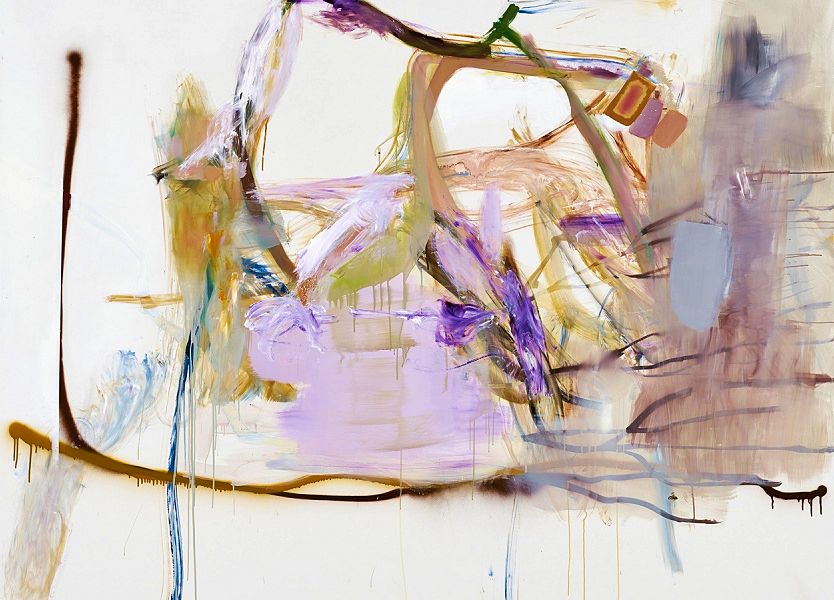
Untitled 2014
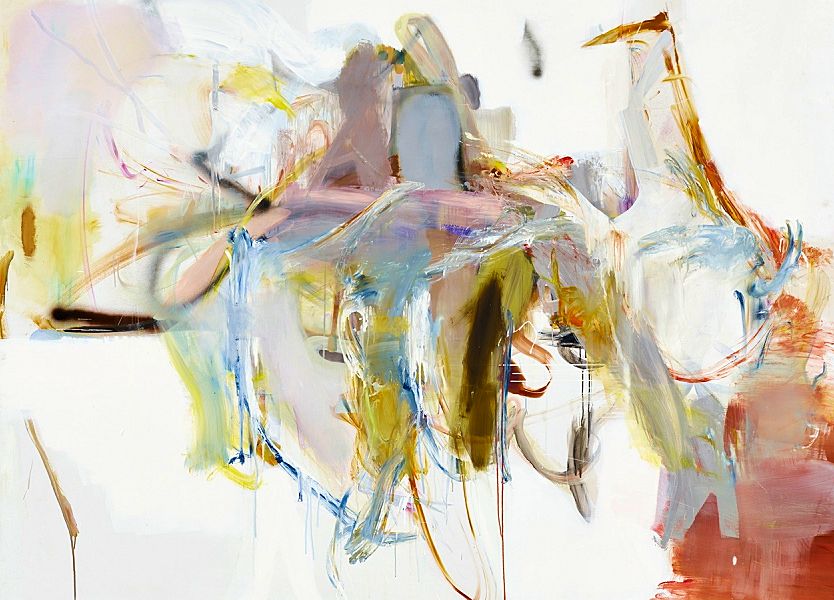
Untitled 2014
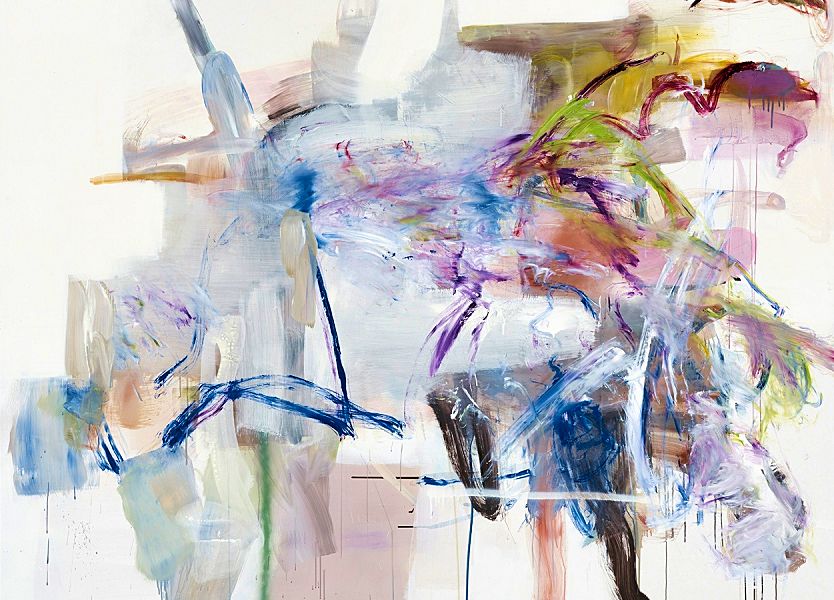
Untitled 2014
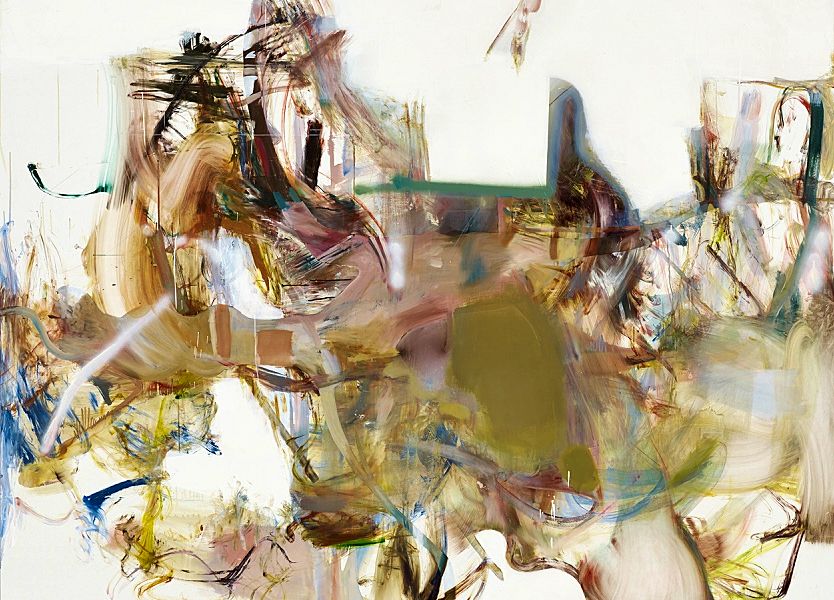
Untitled 2014
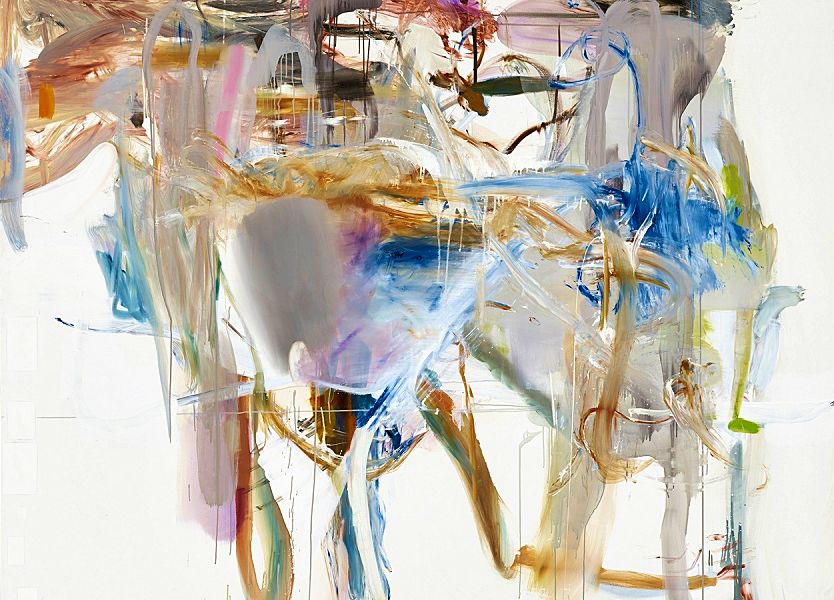
Untitled 2014
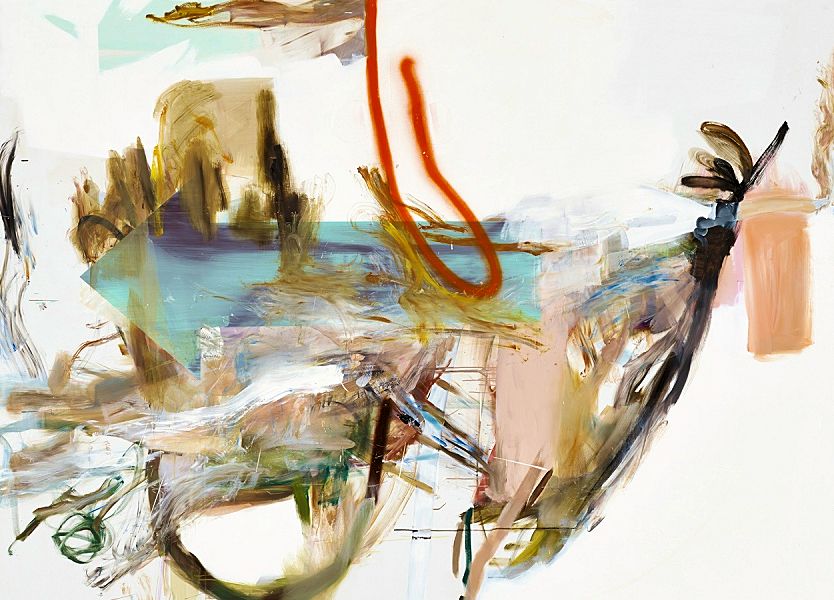
Untitled 2014
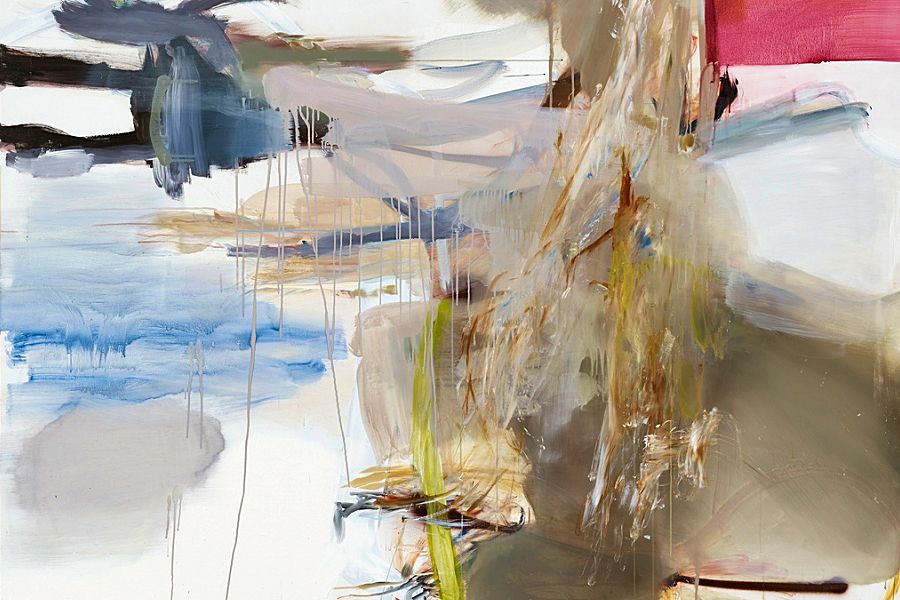
Untitled (detail) 2014
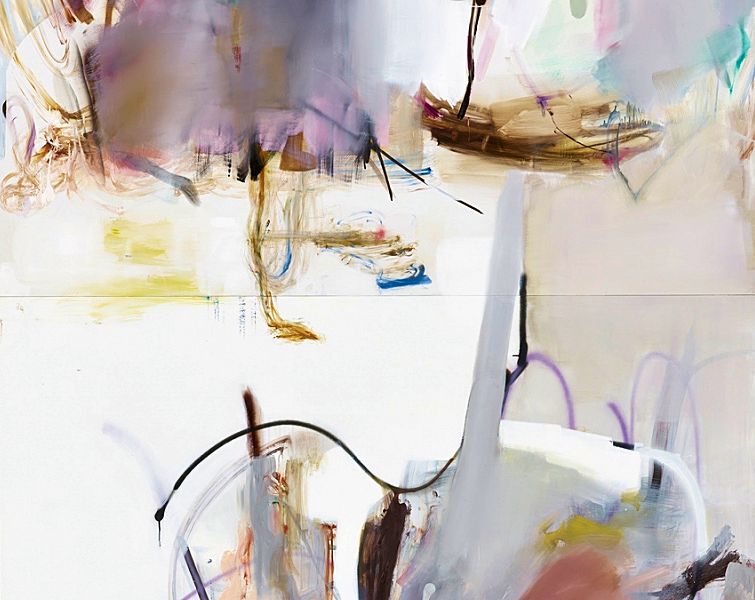
Untitled (detail) 2014
| |
close-up:
Hand Apart
Jordan Kantor on Albert Oehlin's "Fingermalerei," 2008-
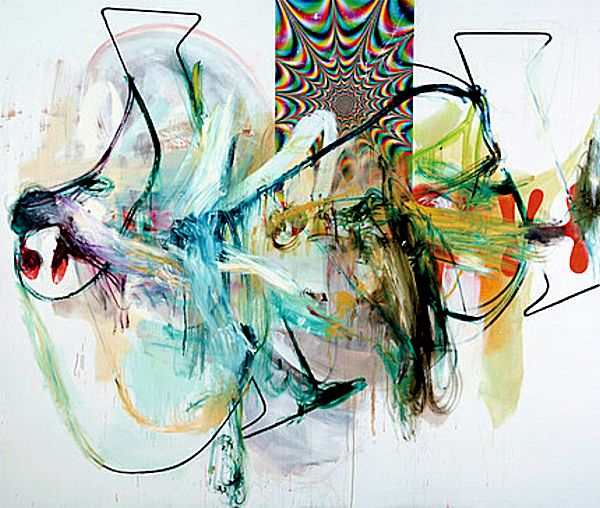
Albert Oehlen, FM 17, 2008, oil, paper on canvas, 90 1/2 x 106 1/4.
These days, artists don’t paint with their fingers much—but since 2008, Albert Oehlen has not been afraid to get his hands dirty. To make his large-scale "Fingermalerei" (Finger Painting) works, the German artist jettisons the brush and instead applies paint to the canvas surface directly with his bare hands. Following his previous body of work—in which collaged, printed elements jostled with campaigns of virtuoso brushwork in visual mash-ups—this series constitutes a new chapter in Oehlen’s sustained investigation into gesture and how it might signify in the context of contemporary painting. Beyond evoking the usual associations (action painting and Gutai, graffiti and children’s first art projects), the works beg a multitude of pressing questions: Does the handmade mark still indicate an auratic presence or an artistic expression? Or, alternatively, is painterly gesture always to be understood as qualified and ironic? Or has that notion itself--fifty years after neo-Dada’s deconstruction of AbEx--become academic and irrelevant? Are all mark-making techniques inescapably haunted by their previous artistic uses, even those that would overtly try to deny their conventionality?
While wholly inquisitive, Oehlen’s "Fingermalerei" thankfully leaves such questions largely open. For Oehlen, working color with his fingers is more a means of investigating how one might go about making an abstract picture today--how might one do this at all—rather than an end unto itself or a way to argue a specific point. This is a vital stance to take in an art-critical economy that tends to valorize artists’ canny strategic positioning. Rather than offering a sound bite or statement per se, the "Fingermalerei" works reveal one of the medium’s most accomplished and sensitive practitioners clawing his way (sometimes literally) through his own interrogations in full public view.
Four dozen paintings make up this series to date, and though the group is unified by the peculiar, titular technique of paint application, considerable formal variety is apparent. Some of these paintings are more visually full, with areas of gestural finger painting superimposed on fields of previously worked layers containing brushwork, wiped-down areas, solvent drips, and collaged advertisement posters, text fragments, or printouts of digital images. In these works, the areas of finger painting, applied last, respond to the printed material beneath. FM 17, 2008, for instance, is characterized by sweeping areas of purple, white, and green paint that rearticulate and modify the forms of a computer-generated rainbow sunburst and the ruled outlines of tilting text—offering a visual counterpoint in terms of color, relative weight of shapes, and speed, quality, and direction of line. Oehlen’s technique largely determines the responsive quality of this way of working. The graphic elements are applied to the canvas’s ground beforehand with water-soluble materials, and the oil paint can only be applied subsequently, when manipulation of that earlier stratum of printed images is no longer possible.
This set of technical operations gives the paintings a specifically layered character, in which sequences of image campaigns appear superimposed on one another within a uniform working space--much like the “canvas” familiar to users of image-processing software such as Photoshop. Indeed, the paintings conjure the spaces of the computer screen. One of the first artists to incorporate digitally drawn forms into his paintings (his eighteen-year series of “Computer Paintings,” begun in 1990, was solely dedicated to this technique), Oehlen has long treated the blank ground of his canvas as a kind of default collection space, ready to accept material dropped in from manifestly different sources, at different resolutions, with different color profiles. However, as much as the handmade gesture Oehlen introduces in "Fingermalerei" might lend itself to a comparative analysis against this background, the artist avoids the dualism of an either/or scenario between representation and abstraction, or the found and the invented. Rather, the cultural material and the gestural finger painting are presented as generally equivalent modes of mark-making, each a tool to get the painting working. They are foils for each other on a visual, rather than a semantic, level.
In contrast to such paintings, packed with distinctly layered visual incident, other, more recent pieces, such as FM 45, 2011, are sparser. In these, the finger-painted elements constitute the primary visual action. Laid on the otherwise unarticulated white ground, the finger-painted marks here take center stage, theatricalizing a kind of elemental will to communicate. So while they still operate within the aesthetic sphere of painting, these fingered marks speak to some primary moment of abstraction, when the first artists had an idea that mark-making on a flat picture plane might stand in equivalence to other lived experiences. That Oehlen--a midcareer artist at the top of his game--is exploring the question of beginnings is exciting, and it seems the stakes are much higher in these emptier works. They are certainly more naked. Without the overt tether to our moment that the printed material assures--presenting the painted mark in dialogue with a mechanically made image--here Oehlen asks, simply: What, if anything, can colored scrawls on a large-scale ground mean?
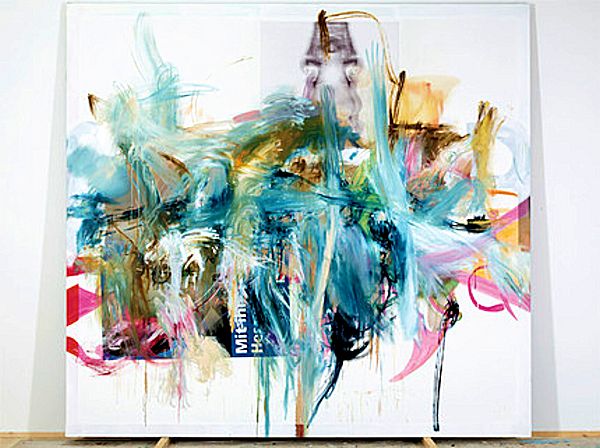
Albert Oehlen, FM 19, 2008, oil and paper on canvas, 110 1/4 x 118 1/8.
Again, Oehlen’s conclusions are more provisional than definitive. He certainly doesn’t seem to be restaging the “tabula rasa” fantasy that has characterized many an abstractionist’s project. Rather, Oehlen pursues a serial structure, he displays the works in mixed groups, and he uses a distinctive (if unprogrammed) set of colors and gestures—all of which implies that no work stands alone. As much as these sparser paintings reduce the visual action to the encounter of pigmented fingers with white field, then, even the barest of the "Fingermalerei" works holds a sense of both freighted past and future potential, implying a space that might be said to be more latent than empty. That is, even when Oehlen makes paintings without printed material, it is as if images and gestures already haunt that space. Perhaps this is how the numerous areas of wiped solvent, like the fissure at the center of FM 45, function: as if to “erase” something previously there.
Absence and mark, void and depth, speak to the conflicting impulses at play in the work and in the language of gestural painting generally. Oehlen has said that all of his abstract paintings come from an inability to paint what he wants to paint. Nevertheless, the paintings embody the dialectical push-and-pull of “I can’t, but I must” that characterizes much challenging art. If the series as a whole demonstrates a will to make beautiful, even facile, abstract paintings, Oehlen’s de-skilled methods also express skepticism, a warning that to do so unconditionally would be inappropriate or impossible. Oehlen is a contemporary through and through, and so he qualifies his utopian bent, his inner Abstract Expressionist, making no absolutist claims to the transcendental power of gesture in itself. Painting with one’s fingers is nothing if not personal, contingent, and minor, after all.
Perhaps what "Fingermalerei" ultimately proposes is that the handmade, gestural mark might, in fact, mean nothing. It might take no recourse to language (a refusal of explanation) but carry an important power to communicate nonetheless: by setting a mood, by evoking a feeling, or by implicating the viewer’s body in imagining the gestures that made those marks. Indeed, this series might help us reframe the essential question of communication and expression that animates all of Oehlen’s paintings: At a time when languages and codes seem to define all areas of experience and understanding, "Fingermalerei" points to the promise of a space beyond linguistic or informatic representation.
If he acknowledges the conditional and partial nature of all communication, then, Oehlen refuses to respond cynically. The "Fingermalerei" paintings seem to propose—contra a linear model of the development of art—that there may still be the possibility of different and unknown experiences, of new visual and corporeal effects that are neither irredeemably burdened with historical baggage nor immediately recuperated into words, slogans, or arguments. Oehlen offers an anticipation of pleasure and thought in this family of mark-making, a desire for what is yet to come.
Jordan Kantor is an artist and an Associate Professor of painting and humanities at California College of the Arts in San Francisco.
Artforum International Summer 2011
|